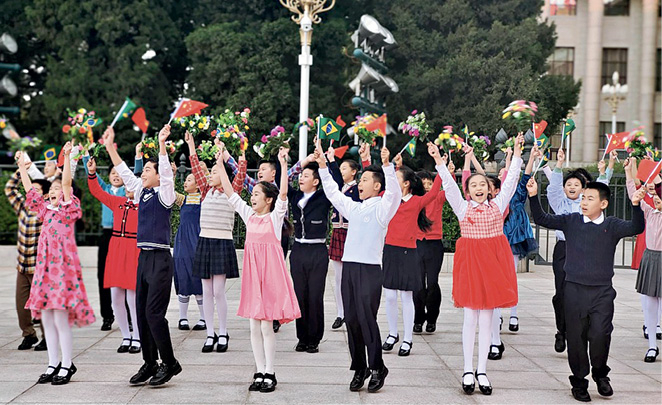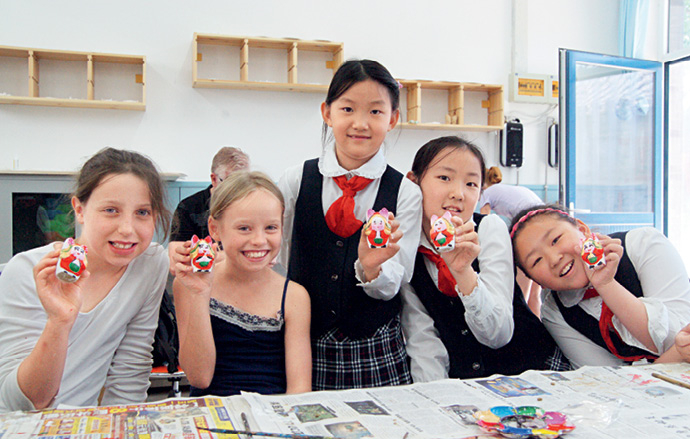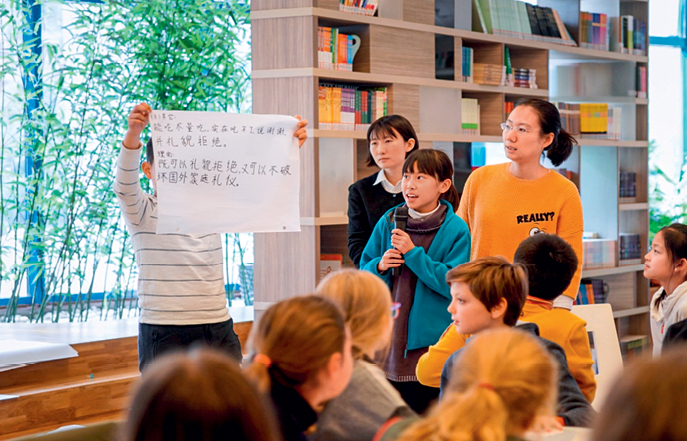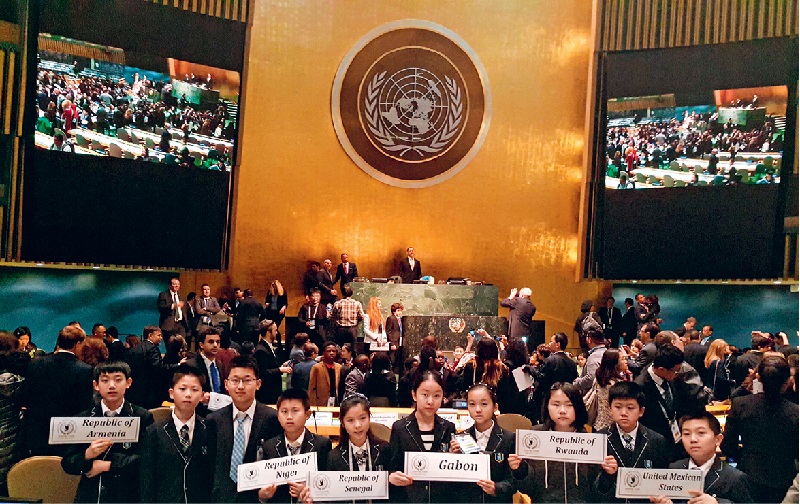
Chinese and foreign students are taking part in a course for international understanding, which aims to increase their ability to communicate with people who have different cultures and values through dialogues.
“Welcome, welcome! A warm welcome! Welcome to Beijing!” A welcome chorus rang out as Brazil’s President Luiz Inacio Lula da Silva arrived at the main gate of the Great Hall of the People in Beijing for a meeting with Chinese President Xi Jinping during his state visit to China in April 2023.
The welcome “committee” was made up of students of the Beijing Shijia Hutong Primary School, an 85-year-old school renowned for its innovative teaching methods and international vision. Fan Weichen was one of the students. He recalled the exciting moment: “A 21-gun salute was fired at the Tian’anmen Square, and a military band played the national anthems of China and Brazil. President Lula, accompanied by President Xi, reviewed the guard of honor of the Chinese People’s Liberation Army. When they passed us, we cheered.”
Yan Xu, who organizes international exchanges at the Shijia school, said the welcome ceremony for visiting heads of state is one of the most important ceremonial activities during their state visits. Taking part in such an international ceremony can give students a global vision, build their national identity and national pride, and develop a sense of being part of an international community. In this way, the seed of serving as “little diplomats” can be planted deep in their hearts.

Students of the Beijing Shijia Hutong Primary School are welcoming Brazil’s President Luiz Inacio Lula da Silva at the main gate of the Great Hall of the People in Beijing for a meeting with Chinese President Xi Jinping during his state visit to China on April 14, 2023.
 Learning without Borders
Learning without BordersWhen the school celebrated its 80th anniversary in 2019, the principal of École Jeannine Manuel, an international school in Paris, which is Shijia’s sister school, sent a glowing tribute. Elizabeth Zeboulon, the principal, wrote, “It is a great honor to be your sister school and share our educational ideas. Our students are eager to visit your campus for exchanges and learning every year. The partnership between the two schools and even between the two countries has boosted international understanding, which holds incredible significance.”
Founded in 1954, École Jeannine Manuel is a French private school where Chinese is a compulsory subject. In 2012, Shijia signed a friendly cooperation agreement with it to organize regular cultural exchange activities, including teacher-student visits, student homestays, teachers’ research and online video exchanges. The sister schools have organized many mutual visits, giving students a chance to experience the cultures of China and France and deepen their friendship.
Students from Shijia traveled to France and visited the Louvre Museum, Palace of Versailles, Musée d’Orsay, and famous chateaus. “We took them to see the local iconic buildings, such as the Eiffel Tower, Arc de Triomphe, and Notre Dame,” Yan said. They also went on a cruise on the Seine River. “It gave them a panoramic view of France’s history and literature,” Yan said. Moreover, the students were taken to the tranquil and artistic town of Barbizon, where they enjoyed an immersive experience of French rural culture. Yan said the children listened attentively as the tour guide talked about ancient European history, literature, sculpture, and art, occasionally asking questions, making it a real enjoyable learning experience.
French teachers and students also visited Shijia for one week of learning, cultural exchanges, and family homestays. The French students experienced different teaching methods and cultural diversity. They tried their hand at traditional Chinese handicrafts like paper quilling. The Chinese host families treated them to Beijing roast duck and bingtang hulu or candied hawthorn sticks. They also learned how to make dumplings.
The cultural exchanges inspire young people to explore the diversity of cultures. Lü Zhehan, a fifth grader at Shijia, started to read European history after his French learning partner returned home. Many French students spoke Chinese, English, and French, and Lü and his schoolmates are inspired to learn more foreign languages so that they could communicate with more young people from other countries.

Foreign children are learning to make a traditional Beijing handcraft called Tu’er Ye, or Lord Rabbit, together with Shijia students.
Close Encounters with Chinese Culture
“Traditional Chinese culture accounts for a major part of our international exchanges, helping children understand its vastness and profoundness,” Yan said.
When teachers and students of the Sidwell Friends School in the United States visited Shijia, they were taken to the National Museum of China for an interactive session on the origin of Chinese characters. They were shown prominent cultural relics, and at the calligraphy exhibition hall, they tried to reproduce ancient Chinese writing on tiles and carvings on bones. Yan called it “an intuitive experience of the long history and culture of China.”
In the school’s art class, students learned about the exquisite blue-and-white Chinese porcelain while a sports class taught them martial arts and etiquette, including humility and respect for their opponent.
Cui Yang, vice principal of Shijia, explained the objective of their international understanding courses. “Carrying forward the 5,000-year-old Chinese culture and embracing the great civilizations on five continents” is the original aspiration, he told China Today. The school has been building multi-level international exchange platforms for students so that they form a strong national identity with a broad world vision, and grow up into 21st century citizens with international literacy.
In 2012, the school applied to the Beijing Office for Education Sciences Planning for a research project, studying how to cultivate primary school students’ humanistic literacy through international exchange and cooperation. With the research project, the school explored ways of integrating international exchange and cooperation into the school’s curriculum in a systematic and sustainable way.
The school today holds three major types of activities. International exchanges include visiting embassies, inviting diplomats to give lectures, and organizing mutual visits to friendly schools.
The “Borderless space for international education” program focuses on building venues both on and off campuses for learning traditional Chinese culture. Such venues include centers for learning about the traditional Chinese musical instrument guqin, Peking Opera, calligraphy, traditional Chinese painting and artworks, the art of tea making, Chinese cooking, Chinese characters, bronze casting, and woodblock printing.
The third type, curriculum for international understanding, is comprised of activities for fostering cultural understanding, national identity, and global responsibility.

Yan Xu is teaching a course called “A dialogue starts from a bar of chocolate,” which aims to increase students’ understanding of different cultures.
Understanding Cultural Differences
“Different understandings and coexistence” is a major topic. The school has developed a course with Beijing Normal University and Japan International Education Society. Called “A dialogue starts from a bar of chocolate,” it aims to increase Chinese and Japanese primary students’ understanding of different cultures and their ability to communicate with people with different values and behaviors through dialogues.
Yan and a Japanese teacher from Japan’s Miyagi University of Education Affiliated Primary School created a scenario of cross-cultural conflict. Primary school students surnamed Wu and Yi are friends sharing a room while traveling. Wu put a bar of chocolate on the table and went out. When he came back, the chocolate was missing. Yi told him that he had eaten it. Students are asked how they would respond if they were Wu. They can choose from several options: A. I don’t mind as we are good friends; B. I feel bad but won’t let it ruin our friendship; C. I am not happy and hope it won’t happen again; D. I can’t understand Yi’s behavior and will not be friends with him anymore.
The options the Chinese and Japanese students chose were different. Most students at Shijia Hutong Primary School chose A or B, indicating that they consider it acceptable for close friends to eat their snacks without telling them. However, most Japanese students chose the last two options, indicating they thought it was impolite and unacceptable to eat others’ snacks without asking them.
The teacher asked another question: “How do you understand etiquette and friendship? Why do we make choices so differently?” After a discussion, the students realized that they make different choices because of different education and growth environments. They also realized that there might be misunderstandings between different cultures, so when they encounter behaviors that they disagree with or cannot understand, they should rethink it from the perspective of that person’s identity, culture, and values, and try new ways for effective communication and meaningful dialogue.
“It offers an opportunity for students to share their ideas,” Yan said, adding that an after-class survey found that students liked that class much more than the traditional ones, as they could say what they felt without the teacher overruling them. The innovated teaching methods and rich contents impact both the students and teachers, facilitating a more diverse way of viewing the world, reflecting on cultural differences and ultimately achieving mutual understanding.

Students of Shijia Hutong Primary School pose for a group photo while participating in the Model United Nations in the United States in March 2016. Courtesy of Shijia Hutong Primary School
“In today’s society, cross-border and cross-cultural flows have become frequent. It is therefore important for students to understand people of different races with different cultural backgrounds and values through education for international understanding,” Cui said. “It has become a basic skill for students in the era of globalization.”
Currently, students from Beijing Shijia Hutong Primary School are making short videos to tell the story of the Belt and Road Initiative, the Central Axis of Beijing, an imaginary line connecting iconic buildings and important structures associated with state power, and “My Hometown Beijing.” With their cross-cultural thinking, they hope to tell the world good stories of China.